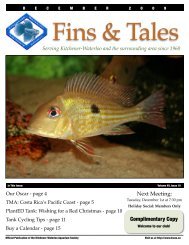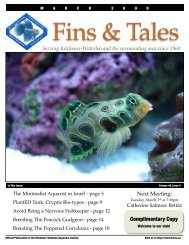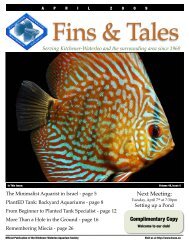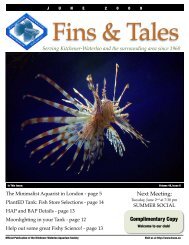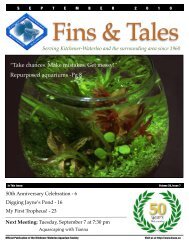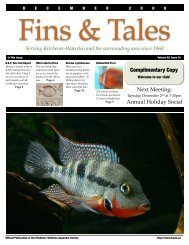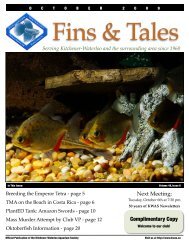April 2010 - Kitchener Waterloo Aquarium Society
April 2010 - Kitchener Waterloo Aquarium Society
April 2010 - Kitchener Waterloo Aquarium Society
Create successful ePaper yourself
Turn your PDF publications into a flip-book with our unique Google optimized e-Paper software.
A P R I L 2 0 1 0Exchange Editor’s ReportSubmitted by Zenin Skomorowski, KWAS (zenin@golden.net).The newsletters featured in this column and others are available toyou. Please let me know by email, or at the monthly meeting, whichones you would like to read.Have you spent very little time with your fish due to workcommitments or other distractions, only to find later that yourfish have spawned ? Well that happened to Joel Antkowiakand his Chalinochromis ndobhoi. These easy to care for torpedoshaped fish from Lake Tanganyika raised their fry andprotected them from other fish in the tank. Read all about it inthe February <strong>2010</strong> issue of Tank Tales from the <strong>Aquarium</strong> Clubof Lancaster County. Also in this issue is a reprint of ScottGraner’s article on The Rainbow Darter. These native NorthAmerican fish are the most vividly coloured of the more than140 species of Darters. They can be bred in the homeaquarium, given the right water temperatures, food and waterflow.Charlie Drew has spawned the HY511 Tetra. ThisHyphessobrycon species is similar to Ornate Rosy Tetra andhas white fins and a rosy red body. It is a peaceful fish thatgrows to about 6 cm ( 2.5 inches ). The spawning and frygrowth is similar to other tetras. Feeding the fry requires verysmall foods such as infusoria. Also in the February <strong>2010</strong> issueof The Monthly Bulletin from the Hamilton and District<strong>Aquarium</strong> <strong>Society</strong>, is an article “Pretty as a Peacock” by LarryJohnson. He has visited the rift Lake Malawi many times andhas imported many peacock species and other cichlids toCanada. The Peacock he has chosen to write about is theAulonocara sp. “yellow collar”. It is dark blue fish with adorsal margin of white, tipped with some yellow. The YellowCollar name comes from the yellow area that is behind thegills and rings the body. Breeding and feeding is easy. Theyhave a gentle disposition and can be kept with most otherAfrican rift lake cichlids.Spring in the aquarium hobby is when the club auctions beginagain. Bruce Hart gave his “Top 10 Reasons I like FishAuctions” in the February <strong>2010</strong> issue of Aqua Antics from theSarnia <strong>Aquarium</strong> <strong>Society</strong>. See how many reasons match yourlist. For me, I see fish at the auction that I never see in thelocal shops, the plants are large and inexpensive, and I get tosee other fellow hobbyists that I have not seen for a while.Also in this issue, Peter Melady wrote about “Pearls In MyTank”. These beautiful Pearl Gouramis are bubble nestbuilding anabantids. Some attention is required to feed andraise the tiny fry.Have you ever had a trio of Angels raise a batch of fry ? JimPeterson had a large albino pearl male, a small koi female anda koi male look after fry from the albino pearl and the koifemale. The male koi decided to help out looking after the fry.Three weeks later there was another spawn. Read about theseevents in “Angel fish Surprises” in the February <strong>2010</strong> issue ofParadise Press from the Long Island <strong>Aquarium</strong> <strong>Society</strong>. Also inthis issue, Darryl Shaber wrote about “Our Trip to Atlantis FishHatchery” in Gardiner New York. They specialize in Africancichlids from Lake Tanganyika and Malawi.A possible addition to our club library is Catfishes by Lee Finley.Susan Priest reviews this new publication in her column WetLeaves in the March <strong>2010</strong> issue of Modern <strong>Aquarium</strong> from theGreater City <strong>Aquarium</strong> <strong>Society</strong> New York. There is lots ofinformation on choosing, feeding, health care, and breeding ofcatfishes. There are also extensive notes from the author’sexperience. There is even a section on appropriate medicaltreatment should you sustain a sting or puncture wound from acatfish. Also in this issue, Dan Radebaugh talks about theChocolate Cichlid Hypselecara temporalis. This larger fairlydocile cichlid from the Amazon looks fairly plain when small,but grows into a dramatic example of mood colouration. Theyhave a base colour of olive or emerald green, with chocolatebrown, purple or red highlights. They are a large, peoplefriendly and colourful fish that will look good in a large showtank.The Perfect <strong>Aquarium</strong> Filter? Jules Birnbaum discusses thehistory of filtration in aquariums. Several types are comparedalong with the merits and use of various filter media. For Jules,a good filter is light weight, easy and fast to service, has amaintenance free motor, a water polishing feature, an on/offswitch, a long warrantee and is moderately priced. See all thedetails in the March <strong>2010</strong> issue of Pisces Press from the NassauCounty <strong>Aquarium</strong> <strong>Society</strong>.Does water temperature determine the ratio of males andfemales in a batch of fry ? For Shawna Foster it sure did. Shenever got any males in her Rosy barb fry. It was suggested thatthe water temperature should be higher than the 74-75 F shehad for them when spawning. Check more details on spawningBarbus conchonius in the March <strong>2010</strong> issue of Aqua Antics fromthe Sarnia <strong>Aquarium</strong> <strong>Society</strong>. Also in this issue, Peter Meladydetails his experience with Neolamprologus signatus. This LakeTanganyikan shell dweller will also dig tunnels in the muddy/sandy substrate. Read more here on the tank setup, feeding andbreeding these dwarf cichlids. - ZeninAnother club has been added to our newsletter exchange:The <strong>Aquarium</strong> Club of Lancaster County – in south-easternPennsylvania www.aclcpa.org 11




